With coral reefs worldwide facing rapid decline due to human activities and climate change, human-assisted coral reef restoration has become more critical than ever. By transplanting coral fragments from healthy colonies or nurseries to degraded areas, we actively accelerate reef recovery. This vital process helps to rebuild marine habitats, restore biodiversity, and re-establish essential ecosystem services like coastal protection and food security. The cornerstone of this effort is coral outplanting, where corals are grown in nurseries and then strategically re-introduced to degraded reef sites.
There are many diverse and effective methods for coral outplanting, each with its own advantages and considerations. In this post, we’ll explore seven primary techniques utilized by Ocean Gardener: Mesh, Cyanoacrylate (super glue), Underwater Drill, Coral Clips, Nail and Cable Ties, Epoxy, and Cement. You can get hands-on experience with these methods through our comprehensive Full Coral Restoration Certificate course.
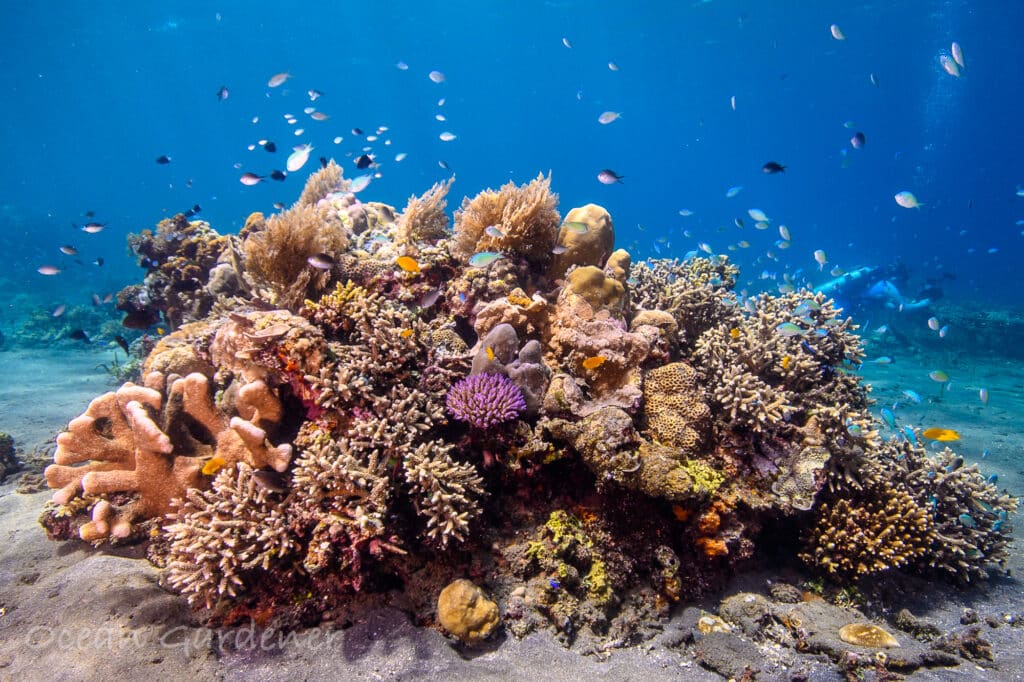
The Toolbox Of Outplanting Techniques
When it comes to coral reef restoration, there’s no one-size-fits-all solution. The most effective outplanting method depends heavily on factors like the substrate, the specific coral species you’re planting, and the unique characteristics of the habitat you’re working in. Our goal at Ocean Gardener is to equip our students with a comprehensive toolbox of techniques, ensuring they can confidently apply the right method in a wide range of real-world conditions.
Sources of Coral Fragments for Outplanting
Corals of Opportunity: These are coral fragments that have naturally broken off from colonies due to storms, boat groundings, or other disturbances. Instead of letting them die on the seafloor, restoration practitioners can collect these “orphaned” fragments and either directly outplant them or place them in nurseries for further growth and recovery. This method is highly sustainable as it utilizes corals that would otherwise perish.
In-situ (Underwater) Nurseries: In many cases, corals of opportunity might not be available to support large reef restoration projects. Donor colonies will need to be grown in managed underwater coral nurseries. This is the method we use most at Ocean Gardener as we have over 25 years of coral farming experience. After carefully selecting the appropriate species and phenotype to suit the target restoration area, we grow these corals in our shallow-water nurseries. This environment allows them to slowly adapt to slightly higher temperatures and light levels, preparing them for the reef. Once they reach an optimal size, typically macro-fragments between 8 and 15 cm, they are then collected and ready for outplanting onto the degraded reef. In-situ nurseries are less expensive to establish and operate than ex-situ nurseries, but are exposed to environmental extremes like strong storms, heatwaves, and disease outbreaks.
Ex-situ (Land-based) Nurseries: These involve growing corals in tanks on land with carefully controlled water parameters. This method offers even more control over environmental conditions and can be particularly useful for sensitive species or for techniques like micro-fragmentation (cutting corals into very small pieces to accelerate growth, especially for massive corals). These are typically much more expensive to build and operate due to the sophisticated equipment and the electricity and staff needed to run it. We do not use this method.
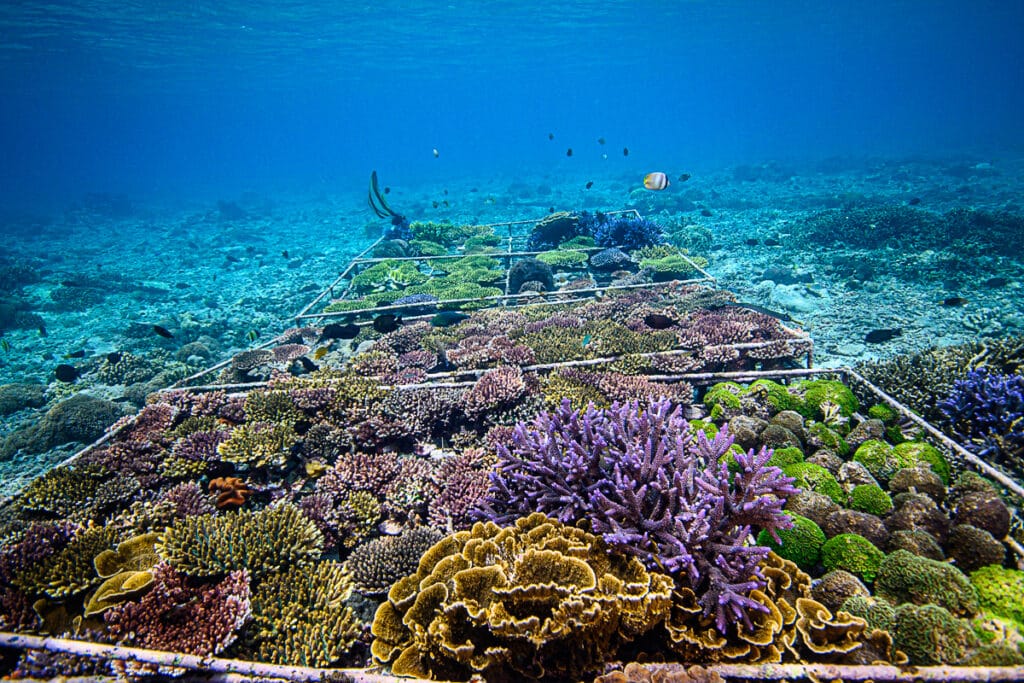
Method 1 : Cement
Cement stands out as a preferred outplanting method, particularly for its affordability and widespread availability, even for small island communities and the most remote locations worldwide. While its production isn’t the most environmentally friendly, its ease of use, low cost, and accessibility often outweigh these concerns. This makes it an especially practical solution in developing island nations like Indonesia, which comprises over seventeen thousand islands.
The trick to outplanting with cement lies in achieving the right consistency when mixed with seawater. You’ll want a paste-like texture that effectively anchors the coral fragments to the substrate. This can be a bit tricky, with the most common mistake being the addition of slightly too much seawater.
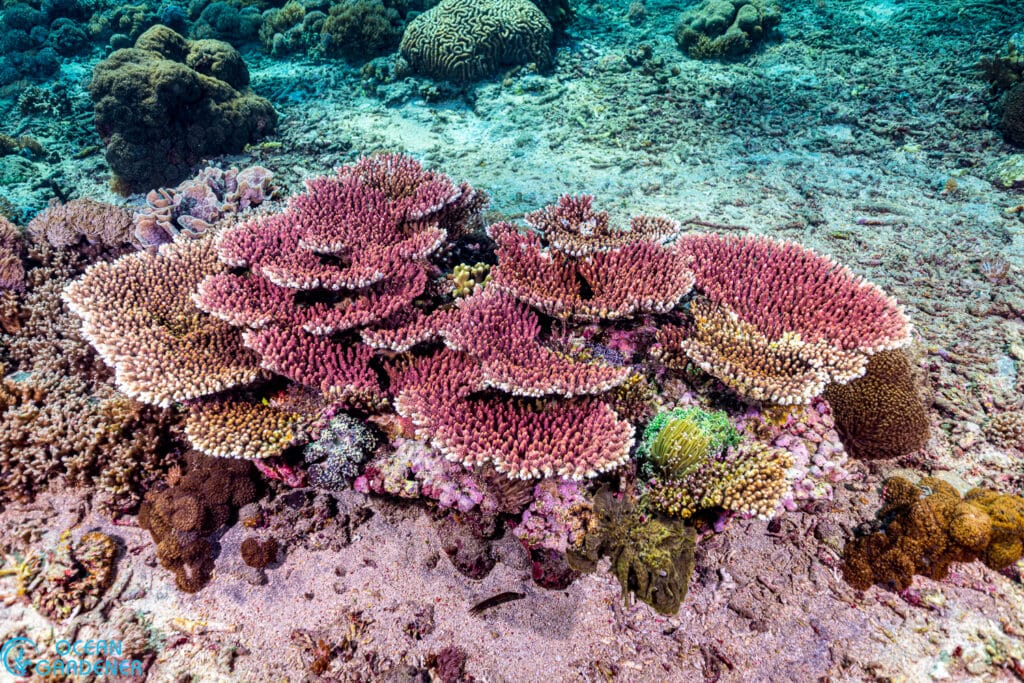
Method 2: Epoxy
Epoxy offers a versatile range of options for coral outplanting, allowing for precise attachment. While some types need to be mixed on land and applied quickly before hardening, others are specifically designed for underwater mixing and application. These underwater epoxies are incredibly convenient for smaller-scale, targeted reef restoration efforts, especially in the immediate aftermath of large storms. They enable rapid stabilization of freshly broken or dislodged coral fragments, preventing further damage and quickly securing them without the need for extensive equipment. Their ability to adhere robustly to vertical or even inverted surfaces is also a significant advantage, allowing for restoration in complex reef topographies like ledges, overhangs, and reef walls, which other methods might struggle with.
However, epoxy’s drawbacks are notable. It comes at a relatively high cost per application, making it less feasible for very large-scale projects. It can also be difficult to source in remote areas due to its specialized nature and shipping regulations for chemical products. Furthermore, its classification as a petroleum-based product raises environmental considerations for some practitioners, though its targeted use aims to benefit the marine environment.
During our course, we provide hands-on training with three distinct types of epoxy, each suited for different applications: polyester epoxy for its strong bonding when gluing corals outside of water (e.g., in a lab or staging area), and both non-sag epoxy (ideal for adhering fragments to uneven or vertical surfaces without slumping) and mortar epoxy (a thicker, more moldable compound often used for larger fragments or filling gaps) for various underwater applications.

Method 3: Nail and Cable tie
The Nail and Cable Tie technique is a classic outplanting method that remains highly effective, particularly when working on hard substrates where hammering concrete nails is feasible. The process is straightforward: two nails are hammered into the substrate in a “V” shape. A coral fragment is then carefully placed between these nails, and a cable tie is used to gently but firmly push the coral down, securing it against the substrate.
From a cost perspective, this method is generally quite economical. The materials – concrete nails and plastic cable ties – are widely available and relatively inexpensive, especially in bulk. This keeps the material cost per coral fragment significantly lower than methods relying on specialized epoxies or even some cement formulations. While it might require slightly more diver time per outplanted coral compared to very fast methods like cement blobs, the low material cost often makes it a preferred choice for projects with budget constraints or in regions where other specialized materials are hard to procure.
A common concern with using nails in seawater is rusting. While concrete nails are designed to be relatively robust, they are still prone to corrosion in the marine environment over time. However, this is often mitigated by the coral’s own growth. If the coral fragment is appropriately selected to match the specific environment and protected from predators, it will quickly overgrow the cable tie and nails, eventually encasing them entirely within its growing skeleton. Once fully overgrown, the metal is encapsulated, and its potential impact is significantly reduced as the coral’s skeleton provides a protective barrier. Some practitioners may also opt for galvanized or even stainless steel nails for increased corrosion resistance, though this would slightly increase the material cost.
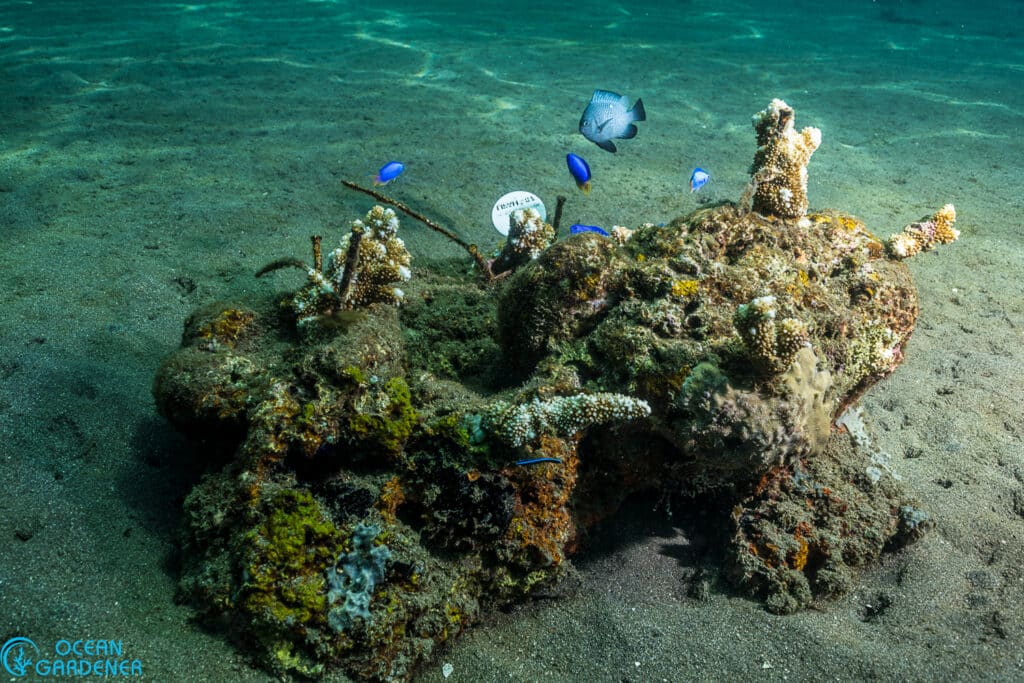
Method 4: Coral Clips
Coral clips represent an innovative outplanting solution, a patented Australian invention designed to efficiently secure coral fragments. Each clip integrates a robust concrete nail with a hardened steel wire, which is coiled around the nail and extends outwards. The methodology is remarkably straightforward: the concrete nail is hammered firmly into a suitable hard substrate, and subsequently, a coral fragment is carefully positioned underneath the wire, which then provides a strong and steady hold, pressing the fragment against the rock to facilitate rapid natural attachment.
The primary advantages of coral clips lie in their simplicity and ease of use, allowing for quick deployment underwater and thus minimizing valuable diver time. Their design ensures a strong immediate hold, which is crucial for preventing fragments from being dislodged by currents or minor disturbances, particularly effective on solid rock or dead coral skeletons. This makes them a highly efficient option when working on stable, hard substrates.
However, the use of coral clips also comes with specific considerations. As a patented product, they can be more expensive than simpler alternatives like nails and cable ties, and their specialized nature might make them harder to source in remote restoration areas. A significant point of concern is the steel wire’s susceptibility to corrosion in the marine environment. While the coral fragment is expected to rapidly overgrow and encapsulate the clip, the initial rusting could potentially impact highly sensitive species or the immediate microhabitat. Furthermore, like all outplanting techniques, the success of coral clips still relies heavily on the careful selection of the right coral species that is ecologically suited for the specific environmental conditions of the restoration site.
Method 5: Underwater Drill:

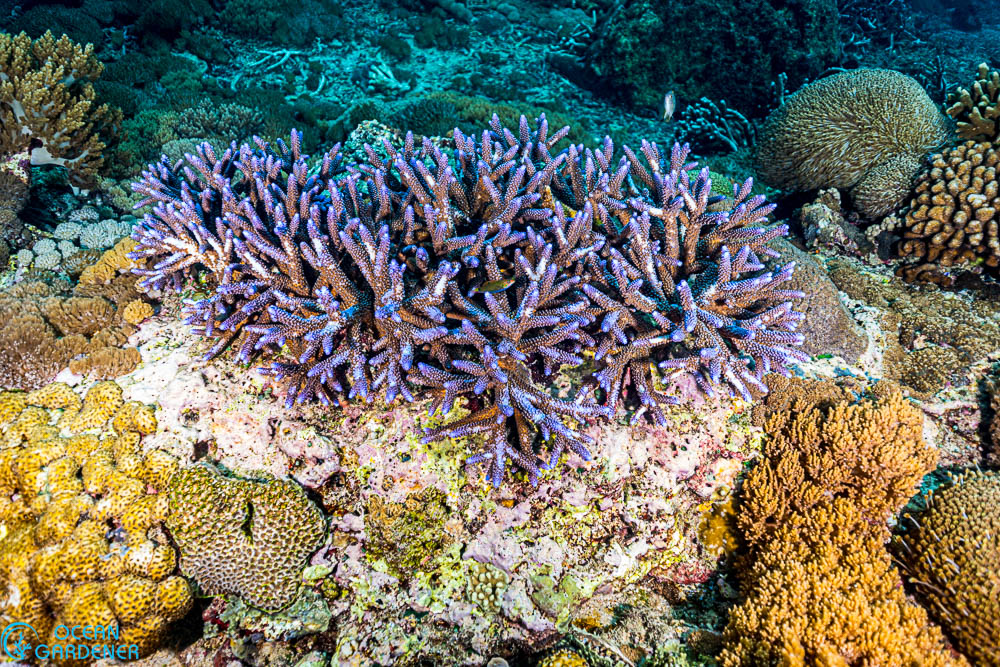
The underwater drill is a specialized and highly effective tool for coral reef restoration, particularly when a robust and secure attachment is paramount. This technique involves drilling precise holes directly into the hard reef substrate. Once a hole is created, coral fragments can be firmly inserted and secured using various attachment methods, such as marine-grade cement, epoxy, or cyanoacrylate (super glue). This provides an exceptionally strong anchor for the corals, making it ideal for outplanting in high-energy environments where waves and surge could easily dislodge less securely attached fragments.
While offering superior security and stability, which significantly reduces the risk of fragments washing away, and allowing for precise placement and spacing of corals, this method does present some challenges. The cost of the specialized underwater drill itself is high, and its reliance on batteries means power needs to be managed for limited dive times. Furthermore, operating it effectively and safely requires specialized training and skill to avoid undue stress or damage to the existing reef structure. Compared to simpler methods, the drilling process can also make it more time-consuming per fragment, which might limit its application for very large-scale, rapid deployments.
Method 6: Cyanoacrylate (Super Glue)
Most standard cyanoacrylate glues aren’t suitable for underwater use, as they react quickly with seawater carbonates and lose their adhesive properties. However, specialized marine-grade formulations, when used correctly, can be effective for securing small coral fragments onto clean, prepared surfaces.
This method offers a very fast and simple attachment for tiny fragments, requiring minimal equipment beyond the glue itself, making it particularly useful for quickly securing minuscule pieces onto irregular surfaces where other methods might be impractical. Yet, its application is quite limited to very small fragments and exceptionally clean surfaces, as any sediment or organic matter will compromise the bond. It’s also not suitable for high-energy environments or for attaching larger corals due to its weaker overall bond compared to cement or epoxy, and the cost per large fragment can quickly become prohibitive. Hence this method is not frequently used.
Method 7 : Wire Mesh
Coral rubble areas present a significant challenge for restoration practitioners, as corals cannot establish themselves on an unstable, shifting base. A highly effective method for stabilizing these difficult seafloors is the use of wire mesh. This technique involves unrolling mesh over the rubble substrate and securely fixing coral fragments onto it using cable ties, ropes, or wire.
This method offers a clear advantage by providing a stable foundation, effectively preventing fragments from being dislodged by currents or wave action. It also creates a larger, interconnected surface area for coral growth, facilitating faster recovery of the degraded site. However, installing mesh can be labor-intensive, demanding significant diver time to properly deploy and secure it across a large area. The material cost, while not as high as specialized epoxies, can still add up for extensive projects. Additionally, practitioners must ensure the mesh itself is marine-grade and durable to avoid it becoming marine debris or causing entanglement issues if not properly secured long-term.

Mastering the Outplanting Toolbox
Mastering the diverse array of outplanting techniques is crucial for any effective coral reef restoration practitioner. Each method, from the simplicity of cement to the precision of an underwater drill, or the stabilizing power of mesh, serves a specific purpose in varying conditions and with different coral species. By understanding and expertly applying these techniques, along with others, practitioners gain the versatility needed to maximize success across a broad spectrum of habitats and restoration challenges. This comprehensive skillset is a cornerstone of our Full Coral Restoration Certificate course, designed to equip you with the practical expertise needed to truly make a difference in revitalizing our world’s coral reefs.